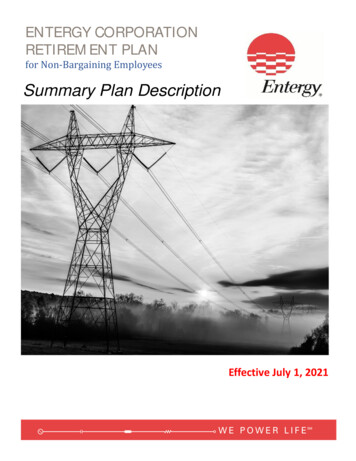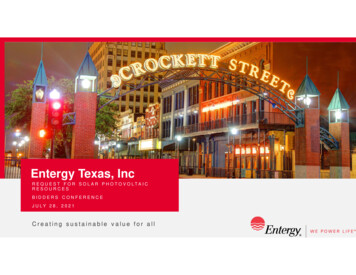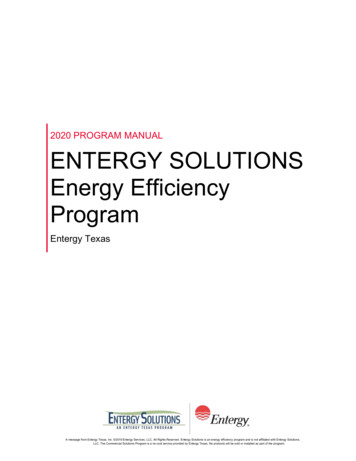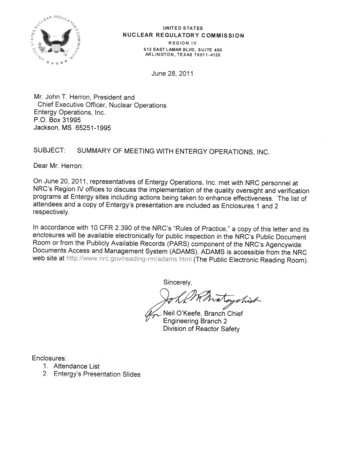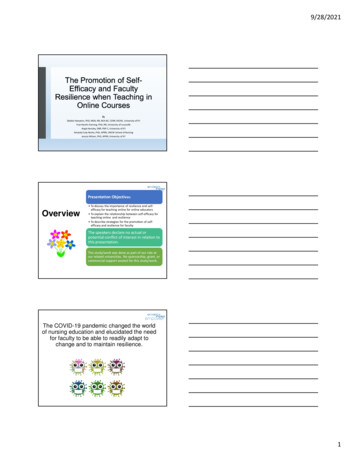
Transcription
ENTERGY’SRESILIENCE PLANEntergDOE Partnership for Energy Sector Climate ResilienceDecember 2016I.;\
I. Introduction, Purpose, and ScopeII. Entergy’s Operations and AssetsIll. Risks and Vulnerabilitiesa. Sea Level Riseb. Subsidencec.Coastal ErosionU. Extreme Weatheri.Ice Stormsii.Hurricanes/Tornadoesiii.FloodingIV. Resilience MeasuresEnterprise Risk Management and Investment Approval Processb. Hardening Studya.Generation Portfolio Transitiond. Nuclear Flood Hazard Evaluationc.e. Grid Infrastructure Investments and Upgradesf. CO2 Stabilization Commitment and the Environmental Initiatives Fundg. Dow Jones Sustainability Indexh. Resiliency Governance and Organizationi. Transmission Planning, Engineering, and Operationsii. Business Continuityiii. Incident Management Systemk.Adaptation StudyBlue Ribbon Resilient Communities ProjectAdvanced Meter InfrastructureI.DOE Partnership1.j.m. City of New Orleans Resilience Strategyn. DOE Grid Analysis for New Orleanso. Council of the City of New Orleans Resolution R-15-31p. United States Business Council for Sustainable Development (USBCSD) WaterSynergy Projectq. USBCSD Watershed SimulationV. Evaluating Future ActionsResiliency Peer Groupb. Stakeholder Engagementa.c. Technology Innovation and Implementationii Page*URL5 for the underlined links can be found in Appendix C
I.Introduction, Purpose, and ScopeEntergy Corporation defines resiliency as the ability to prepare for, adapt to, and recover fromnon-normal events. As an electricity generator and provider, Entergy plays a key role in thecommunities that it serves, since the electrical system contributes substantially to withstandingand recovering from such events.The scope of this plan includes all of Entergy’s assets, operations, and service territories, asdescribed in the report below. The overall purpose of this report is to examine Entergy’s assetsoperations, risks, vulnerabilities, and role in overall community resiliency1, to examine risks andvulnerabilities, to describe the historical/existing portfolio of resiliency measures and Entergy’svision of the future in terms of community resiliency in the areas the company serves, and toexplore and describe potential future resiliency measures.Entergy has a long history of strong environmental performance and commitment. Beginning in2001, Entergy established a corporate environmental strategy, which has been renewed andexpanded twice in the past 15 years. The current environmental strategy extends through 2020and focuses on environmental footprint reduction, proactive adaptation, complianceleadership, energy efficiency, clean generation, and stakeholder engagement. More onEntergy’s overall environmental strategy can be found at www.entergy.com/environment/”.II.Entergy’s Operations and AssetsEntergy Corporation3 is an integrated energy company engaged primarily in electric powerproduction and retail distribution operations. Entergy owns and operates power plants withapproximately 30,000 megawatts of electric generating capacity, including nearly 10,000megawatts of nuclear power.Entergy delivers electricity to 2.8 million utility customers in Arkansas, Louisiana, Mississippi,and Texas. Entergy has annual revenues of approximately 11.5 billion and more than 13,000employees.Providing excellent service is the foundation of the company’s success. Entergy is investing toenhance reliability, improve efficiency, and lower its environmental impact, while exploringnew technologies to improve customers’ experience. The company also continually seeks outopportunities to improve productivity and promote economicgrowth, which helps maintain low rates and enhances the‘tAR.!Icommunities where it operates.USTXThe utility business provides power at favorable rates to residential,‘%r-\commercial, industrial, and governmental customers in Arkansas,‘S ;Louisiana, Mississippi, and Texas. The company also delivers naturalgas to customers in New Orleans and parts of Baton Rouge,Louisiana. One of the company’s strategic imperatives isto grow the utility businessOasEntrgyServk&Territory21 Page*URL5 for the underlined links can be found in Appendix C
aggressively. The company is executing a plan to invest to deliver power safely, reliably, andefficiently, align with its stakeholders’ expectations, and serve its customers with excellence.Entergy Wholesale Commodities’ (EWC) generation fleet provides safe, reliable power forwholesale customers. In recent years, wholesale power generators have been challenged bypersistent low prices due to abundant shale gas. EWC’s strategic imperative is to transition to asmaller merchant fleet while properly managing all risks and safely and reliably operating thesefacilities. The company is managing the EWC transition while continuing to engagestakeholders.Entergy’s physical assets include large central station generation plants of many types, includingfossil-fired, nuclear, and renewable. These plants generate the electricity necessary to supportutility grid operations and to provide service for wholesale customers for EWC. Several ofEWC’s generation assets are located outside of Entergy’s utility service territory—primarily inMassachusetts, New York, and Michigan. Additionally, the utility owns and operates over15,000 miles of high voltage transmission lines operated at 69 kV to 500 kV interconnectingover 1,500 substations and two transmission control centers.The utility also owns and operates distribution lines that deliver retail power to residential,commercial, agricultural, and industrial customers throughout its service territory. In BatonRouge and New Orleans, Louisiana, Entergy owns distribution infrastructure delivering naturalgas to customers. Entergy owns a gas storage facility near Beaumont, Texas and pipelineinfrastructure that transmits that gas to other providers’ assets, as well as one of Entergy’sfossil plants in southeast Texas. Finally, Entergy owns or leases space for support facilities,including office buildings, data centers, telecommunications facilities, supply chain facilities,and an airport hangar.Ill.Risks and VulnerabilitiesEntergy’s assets and the communities it serves are at risk from various physical andenvironmental factors, including:a. Sea Level Rise4’b. Subsidence5’c. Coastal Erosion6’d. Extreme WeatherIce �8*The physical and environmental risks to which a particular asset is subject are highly dependenton its physical location. For example, assets in south Louisiana are rarely subjected to icestorms, but are more likely subject to coastal erosion and subsidence, while the converse is truefor assets located further north.*URL5 for the underlined links can be found in Appendix C31Page
With respect to overall community resiliency, Entergy’s primary acute vulnerability is toextreme weather events that result in outages. A community’s ability to withstand an extremeweather event is sometimes linked to Entergy’s ability to provide electricity to keep electricpowered flood control infrastructure operational (i.e., flood control pumps) and the ability ofemergency services to remain operational. Likewise, electrical power is often critical insupporting an efficient and timely post-event recoverybo*.IV.Resiliency MeasuresFor decades, Entergy has evaluated risks to its operations and assets, including the physicalrisks described above. Each of these resiliency measures is established after a rigorousevaluation of the costs and benefits of establishing a new process, investing in infrastructure, orestablishing organizational and/or management structures.The sections below identify Entergy’s historical and active portfolio of resiliency measures, aswell as potential future actions that the company is evaluating to further enhance its role ofproviding reliable electrical service in order to improve the resiliency of the communities thecompany serves.a. Enterprise Risk Management and the Investment Approval Process Entergy promotesa risk management culture with responsibility for risk identification and assessmentwithin the business units. Our Chief Financial Officer (CEO) provides risk oversight and, ifneeded, quantification through the enterprise risk management (ERM) process.Entergy’s ERM process and investment approval process (lAP) are comprehensivecompanywide processes used to identify material issues and strategic imperatives andto analyze and prioritize environmental, weather, and climate risks and opportunitiesfor all businesses. The scope of the analysis includes climate changelegislative/regulatory proposals, climate change adaptation issues, customer impacts,physical risks (including those related to climate change), economic impacts, andlitigation issues.-Entergy’s Internal Audit Services facilitates risk analysis, including risks posed by climatechange, for all businesses and support groups. Risks are described, evaluated and scoredbased on probability of occurrence and severity of outcome. Controls are established forpriority items and needed testing is conducted periodically to ensure priorities areaddressed. This information is reviewed and updated on a periodic basis.Entergy’s lAP requires all projects of sufficient materiality to include scenarios reflectingthe costs and/or benefits of carbon regulation using the company’s CO2 point of view,which is developed in consultation with ICE International. This includes a range ofestimates of the future cost of carbon regulation/legislation and uses outside forecaststhat are updated at least annually. Entergy performs sensitivity analysis and stresstesting, including climate change risks, on each investment. Entergy performs extensivemodeling and analysis regarding the various legislative and regulatory scenarios forcarbon. From this analysis, Entergy has derived its CO2 Point of View. Capital projectevaluations include costs of compliance for all options across compliance scenarios. For*URL5 for the underlined links can be found in Appendix C41Page
example, the Union Power Project acquisition completed in March 2016 was assessedfor future cost of carbon.b.Hardening Studies In 2005, Hurricanes Katrina and Rita damaged hundreds of acres ofcoastal wetlands, transmission towers, distribution poles and lines, substations, andgenerating facilities, leaving millions of Entergy customers without power. HurricaneKatrina alone led to nearly 300 million in facility improvements and 1.7 billion inhardening investments at Entergyl;*.—However, Entergy’s hardening strategy actually began 40 years earlier when HurricaneBetsy pummeled the region, causing widespread flooding and extensive power outagesin the New Orleans area. Afterward, the company took stock of measures necessary tosustain transmission lines and other facilities during such damaging events. The goal wasto keep storm outage frequency and duration to a minimum. Because Hurricane Betsy’swind speeds topped 140 mph, the company hardened its transmission system wellbeyond National Electrical Safety Code (NESC) requirements.The decision to take this action decades ago proved justified when Hurricanes Katrinaand Rita struck the coastline. Although Entergy sustained significant system damage, a2007 hardening study commissioned by the company indicated that 99 percent of thestructures located within 20 miles of the Louisiana and Texas coastlines survived thewinds. In total, of more than 90,000 structures along that stretch of coast exposed tothe high winds of both hurricanes, only 770 sustained structural damage such as breaksin utility poles. National news photos showed leaning poles, but many of thosestructures were able to be straightened and did not require additional repairs.Major storms like these are not just coastal events. Although NESC changed the codes in2007 to require structures to withstand 140 mph winds along the Louisiana and Texascoastlines, Entergy exceeds these requirements further inland than codes require byhardening our structures to withstand strong winds that accompany hurricanes longafter landfall.Data collected for the 2007 study gave engineers information needed to develop anumber of strategies, including investments that reduce costs to customers over the lifeof the facilities. Steps Entergy has taken include building transmission lines usingconcrete or steel poles within 20 miles of the coast, replacing transmission anddistribution crossing structures over major highways with concrete or steel poles, andbuilding new substations to elevations above the 100-year flood plain, as established bythe U.S. Geological Survey. The current design standards for transmission lineconstruction on Entergy’s system do not allow the use of wood poles. Entergy also hasstudied its distribution system and other structures along the coastl2* and farther inlandand has taken steps to harden and protect those properties from high winds andpotential floodwaters a hurricane can cause. Distribution services centers in NewOrleans East, Chalmette, and St. Rosalie were elevated to provide protection from stormsurge inundation during severe weather events. (See Appendix A Entergy’s climateresiliency chapter in Electric Power Research Institute’s sustainable electricity book)—*URL5 for the underlined links can be found in Appendix CSIPage
c. Generation Portfolio Transition As Entergy designs and builds new generation, thesite selection process involves reviewing the site for access, transmissioninterconnection, fuel supply, and flood potential. To address flooding, the site isreviewed against 100-year floodplain data and specific data associated with the site. Allof the current new generation builds are located at existing Entergy sites where thereexists an understanding of how the site is impacted by flooding. The determination ofthe site elevation takes into account the flooding data to provide reasonable assurancethat the major power block equipment is not impacted by flood waters. The majorpower block equipment includes the gas turbines, steam turbines, transformers, andelectrical switch gear rooms. Also, the site elevation takes into account constructionimpact and costs. In some cases, the site elevation is above the ground water level,which eases the installation of underground components.—During the design phase, wind loading on structures is in accordance with IBC(International Building Code) and ASCE 7 (American Society of Civil EngineeringMinimum Design Loads for Buildings and other structures) standards. ASCE 7 providesusers with site-specific wind speeds used in the determination of the design of windloads for the buildings and structures. ASCE 7 also addresses design loads for seismic,rain, and ice impacts. The IBC addresses the design and installation of building systemsand provides regulations that safeguard the public health and safety in all communities,large and small.—U. Nuclear Flood Hazard Evaluation Flooding hazards have been re-evaluatedsystematically at each of Entergy’s nuclear plants using the latest methodology andinformation beyond original design requirements set by NEI 12-08 Overview of FloodingReevaluations regulations. Sources and standards of methodology and information arefrom national laboratories, national weather service, US Army Corps of Engineers,Federal Emergency Management Agency, Federal Energy Regulatory Commission,Department of Energy, cutting edge researchers and scientists, and other federal andinternational agencies and institutions.-Flooding Hazard mechanisms assessed include extreme hurricanes, tsunami, intenserainfall, flooding rivers, dam failures, ice jams, seiche, and combinations ofthese. Extremely conservative methods were used when substantial plant marginsexisted. Refinements of conservatisms were used where less margins were available.Entergy’s nuclear fleet generally was found to have margins beyond design basis reevaluation providing protection of important plant structures, systems, andcomponents. One plant required a strategy to prepare for an extreme hurricane surgeduring the advance warning time from the National Hurricane Center. Plant staff isprepared and able to execute the strategy.6*URL5 for the underlined links can be found in Appendix CPage
e. Grid Infrastructure Investments and Upgrades Improvements in transmissioninfrastructure provide resilience by updating the physical strength of the overall grid andby creating more efficient ways to move power throughout the system. Entergy’s moveto Midcontinent Independent System operator (MISO) enhanced system reliability byinforming all market participants about the state of grid conditions and marketoperations through the public posting of electricity prices and other key systeminformation. MISO mitigates transmission congestion on a least-cost basis, allowing fortimely and efficient congestion management. Integrating MlSO into the company’sbusiness model has resulted in different flow patterns on the transmission system andhas identified where new transmission facilities and upgrades are economicallyadvantageous. In 2015, Entergy invested more than 630 million in transmissioninfrastructure.—Entergy Arkansas, Inc. (EAI) began construction on a 24-mile transmission line innortheast Arkansas to improve reliability. The 63 million investment is in addition to a 43 million investment in a 25-mile transmission line and a 29 million investment in a22-mile transmission line, both already underway in southeast Arkansas.Entergy Louisiana, LLC fELL) received certification for the Lake Charles TransmissionProject, a 159 million project (excluding contingency) that includes the construction oftwo new substations, the expansion of a third, and the addition of about 25 miles ofhigh-voltage transmission lines to move power reliably and efficiently into this fastgrowing region. Construction began in 2016. Entergy Louisiana has also begunconstruction of the Louisiana Economic Transmission Project, a 67 million portfolio ofprojects that includes a new substation, construction of a new 11-mile transmission line,and the reconfiguration of existing transmission lines in order to reduce congestion inthe Baton Rouge industrial corridor and, generally, to increase the amount of economicpower that can flow into the Amite South region, projected to result in substantialeconomic benefits in the form of lower cost of service for ELL’s retail and wholesalecustomers.Entergy Mississippi, Inc. (EMI) began construction of the 132 million SouthwestMississippi Reliability Improvement Project in the spring of 2016, which includes a new65-mile transmission line and the rebuilding of several sections of existing transmissionlines. The project is needed to maintain compliance with industry standards and supportgrowth in the Natchez area.In early 2016, Entergy New Orleans, Inc. (ENO) completed a 30 million transmissionupgrade to enhance reliability and increase capacity. This is an important step inpreparation for its future generation landscape, such as the recent retirement of itsMichoud generating facility.Three important projects went into service in Entergy Texas, Inc. (ETI) in mid-2016. ThePonderosa—Grimes 230 kV line, the Orange County Project, and the China—Amelia 230kV line together represent nearly 150 million of transmission investment and providereliability benefits throughout the Entergy Texas footprint.*URL5 for the underlined links can be found in Appendix c71 Page
Two new transmission control centers were completed in 2016 in Arkansas andMississippi. Each center represents a 23 million investment and was built to withstandan EF5 tornado. The centers share sophisticated communications technology thatenables close coordination of operations and enhances training and development.CO2 Stabilization Commitment and the Environmental Initiatives Fund On May 3,2001, Entergy made history when it became the first U.S. electric utility to announce agreenhouse gas emissions target. Partnering with Environmental Defense, Entergypledged to take voluntary actions to stabilize its domestic carbon dioxide (C02)emissions at year-2000 levels through 2005 and to develop a long-term target to includeadditional reductions that would help combat climate change.—To help accomplish its emissions-reduction goal, Entergy dedicated 25 million insupplemental funding through an Environmental Initiatives Fund (ElF), with 80%allocated for changes in Entergy-owned assets and 20% for the purchase of CO2 offsets.From 2002-2005, Entergy exceeded its stabilization commitment and further reducedCO2 emissions by 23% under the established target while simultaneously increasingelectrical sales by 21%. Entergy achieved its goal through both internal and externalgreenhouse gas reduction strategies, including 61 internal projects and 13 externalprojects that encompassed carbon sequestration on company-owned property andgreenhouse gas emission trades.In May 2006, Entergy announced a second five-year commitment to stabilize CO2emissions from its owned facilities at a level 20% below year 2000 from 2006-2010.Entergy also included controllable purchases as part of the commitment, since they hadbecome a significant portion of its portfolio. The commitment included 3.25 million infunding to participate actively in GHG offset markets and to help develop new markets,products, and innovations to address emission reductions. Entergy’s cumulative CO2emissions through the years 2006, 2007, and 2008 were 122.9 million tons, 4% betterthan its stabilization goal of 127.7 million tons.Through 2015, since the first stabilization commitment in 2001, Entergy has emitted629.9 million tons of CO2 (including controllable purchases emissions), which is nearly9% below its cumulative stabilization goal of 691.6 million tons of CO2 for the 15-yearperiod. Entergy’s emissions in 2015 were approximately 30% below 2000 levels.The ElF currently is funded by an annual appropriation of shareholder dollars used tofund a variety of environmentally beneficial projects. Through the ElF, Entergy hasmade emission-reduction improvements to its existing fossil fleet, including coal plants,to improve efficiency, and has funded projects such as wetland and coastal restorationthat should increase the sustainability of both Entergy’s assets and the communitiesserved by Entergy. (See Appendix B contains for details on the various types of projectssupportedl3* by the ElF.)ItURLs for the underlined links can be found in Appendix CPage
g.Dow Jones Sustainability Index In 2016, Entergy was once again named to the DowJones Sustainability North America Index. The index measures performance ineconomic, environmental, and social dimensions against industry peers around theglobe. Entergy was one of only four U.S. electric utilities named to the index. Thecompany achieved perfect scores of 100 in the focus areas of Corporate Citizenship andPhilanthropy, Biodiversity, Climate Strategy, and Water-Related Risks. This is the 15thconsecutive year Entergy has been included on either the World or North America indexor both.-h. Resiliency Governance and Organization Entergy’s resiliency governance andorganization is spread throughout the organization in various business functions andplanning processes. These various functions and processes, further described below,are designed to:—1. Reduce the likelihood of an outage;2. Minimize the impact of an outage on customers and company operations;3. Plan for outage response/conduct drills; and,4. Safely recover as quickly as possible from an outage.Transmission Planning, Engineering, and Operations Entergy’s TransmissionOrganization consists of the employees and assets used to plan, operate, and maintainEntergy’s transmission system. The Entergy transmission system is comprised of thetransmission systems of Entergy’s operating companies (EOCs): Entergy Arkansas, Inc.;Entergy Louisiana, LLC; Entergy Mississippi, Inc.; Entergy New Orleans, Inc.; and EntergyTexas, Inc. The Entergy transmission system is comprised of over 15,000 circuit miles oftransmission lines operated at 69 kV to 500 kV interconnecting over 1,500 substations.The transmission system spans portions of Arkansas, Louisiana, Mississippi, Missouri,and Texas, covering 114,000 square miles. This system is regulated by FERC and retailregulators, including the Arkansas Public Service Commission, the Louisiana PublicService Commission, the Mississippi Public Service Commission, the City Council for theCity of New Orleans, and the Public Utility Commission of Texas.-The Entergy transmission system moves high voltage bulk electric power fromgenerating plants of the EOCs and third parties across an interconnected system oftransmission lines and substations. The power is delivered to wholesale customers suchas municipalities and cooperatives, as well as to approximately 2.8 million retailcustomers. The system also delivers power directly to large commercial and industrialretail customers. These customers include refineries, chemical plants, oil and gasprocessing facilities, pumping stations, and large manufacturing sites vital to the regionand nation.Business Continuity— Entergy initially launched efforts to address business continuityneeds in early 2004. However, in the aftermath of Hurricanes Katrina and Rita in 2005, adedicated Business Continuity Team was formed to ensure that Entergy’s business unitscould provide service for essential business functions, either through normal oralternate operations. Today’s business continuity challenges can come from almost*URLs for the underlined links can be found in Appendix C91Page
anywherehurricanes in the Gulf, ice storms, terrorist events, or health pandemics.Entergy recognizes the need to be able to respond accordingly in order to prevent andminimize impacts of these types of events.—Entergy conducts business continuity drills twice a year that simulate different types ofemergencies. Teams complete tabletop drills involving various emergency responsescenarios, including attacks and storm-related emergencies. The event leader isresponsible for coordinating Entergy’s overall business continuity effort, includingsharing business continuity information with employees, business partners, andcustomers. The leader also works with each business unit to resolve issues impactingthe ongoing operations of the business as well as people issues such as acquiringtemporary employee housing and addressing family-care issues in any event that coulddisrupt Entergy’s operations.Entergy’s incident management organizationconducts at least one storm exercise annually to keep personnel educated and adept intheir storm roles and responsibilities. Generally, an exercise is conducted in the springand is focused on preparation and response for a hurricane scenario. Periodically,another exercise is conducted in the late fall and focuses on a winter storm scenario.Additional exercises are sometimes conducted within an individual Office or Sectiongroup of the incident management organization to ensure preparedness of newpersonnel in key storm assignments or for exercising new or enhancedprocesses. Exercises are developed to simulate potential situations expected during thevarious scenarios and are intended to allow for demonstration of proficiency in processunderstanding and execution. The leadership of the incident management organizationalso conducts monthly incident commander steering committee calls that allow forroutine discussion and follow-up on items associated with process development andpreparedness.Entergy’s Incident Management System—Mutual Assistance is a voluntary partnership of investor-owned electric companiesacross the country committed to helping restore power whenever and whereverassistance is needed. Municipal utilities and electric cooperatives also have their ownmutual aid programs that provide restoration support to their participating utilities.Mutual Assistance provides a formal yet flexible process for electric companies torequest support from other electric companies in parts of the country that have notbeen affected by major outage events.Entergy maintains membership and active participation in the following MutualAssistance organizations: Edison Electric Institute Mutual Assistance-Emergency Planning CommitteeMidwest Regional Mutual Assistance GroupSoutheastern Electric Exchange Regional Mutual Assistance GroupTexas Regional Mutual Assistance Group10*URL5 for the underlined links can be found in Appendix CPage
Regardless of the timing or location of a major storm, Entergy’s team stays ready torestore power safely and quickly to our customers. Entergy’s storm response team andprocess are recognized as being among the best in the business.Adaptation Study In 2010, Entergy worked to develop a framework and fact base toquantify climate risks along the U.S. Gulf Coast and to help inform economically sensibleapproaches for addressing this risk and building a resilient Gulf Coast.—This project was strengthened and enriched by contributions from many stakeholdersand participants. Entergy primarily worked with America’s Energy Coast, America’sWETLAND Foundation, and Swiss Re, which was a lead contributor to the research andbrought its natural catastrophe and climate risk assessment knowledge to bear on thechallenge of quantifying climate risks. The methodology used in the study previouslywas devised and tested by a consortium of public and private partners, including SwissRe, in a project on the Economics of Climate Adaptation (ECA). The methodologydeveloped a framework for the facts for decision-makers to build a portfolio ofeconomically suitable adaptation measures.The executive report14’ for the study and a summary presentationls* were bothpublished in 2010. The publication of these results was followed by extensivestakeholder outreach. The stakeholder outreach initiative sought to assess localvulnerabilities along the Gulf
2016 was assessed for future cost of carbon. b. Hardening Studies In 2005, Hurricanes Katrina and Rita damaged hundreds of acres of coastal wetlands, transmission towers, distribution poles and lines, substations, and generating facilities, leaving millions of Entergy customers without power. Hurricane Katrina alone led to nearly 300 million .
